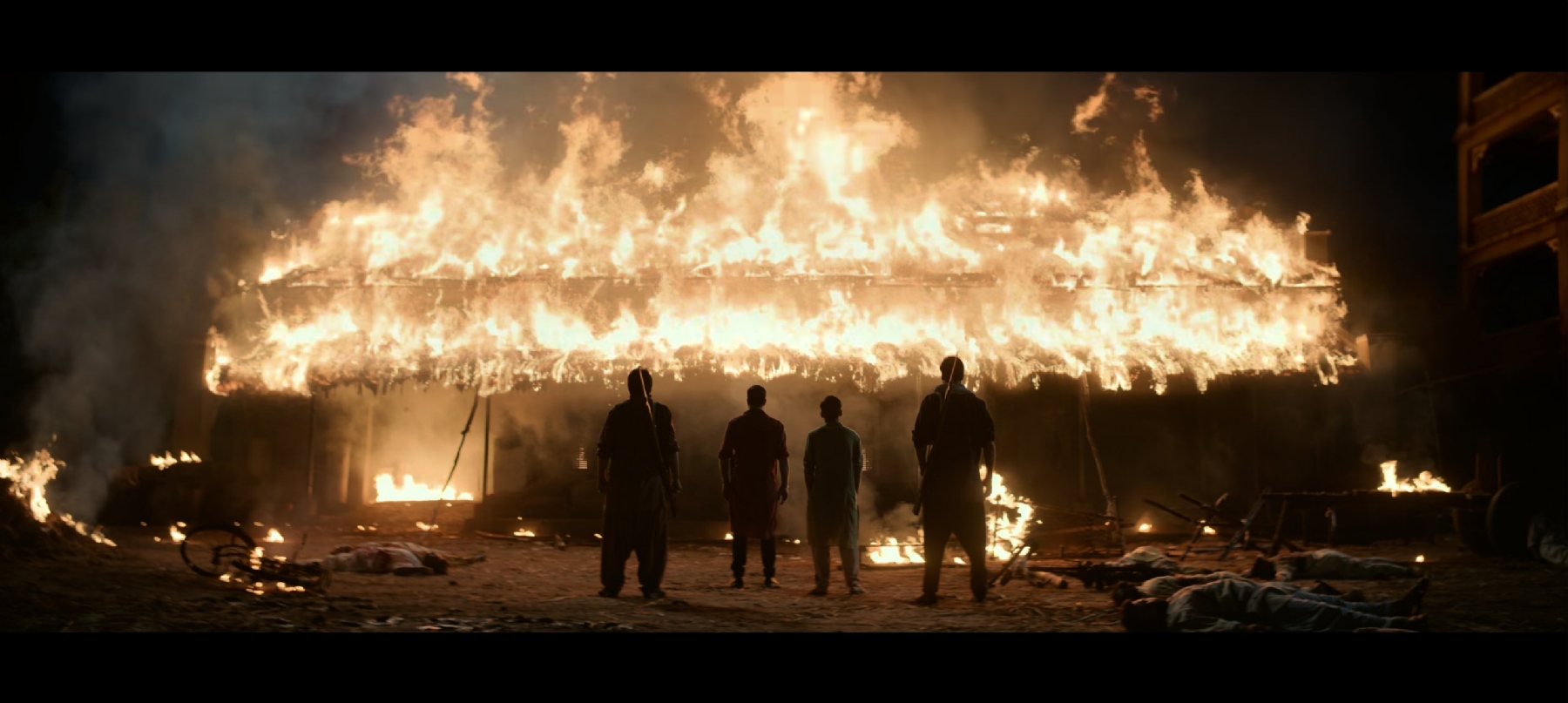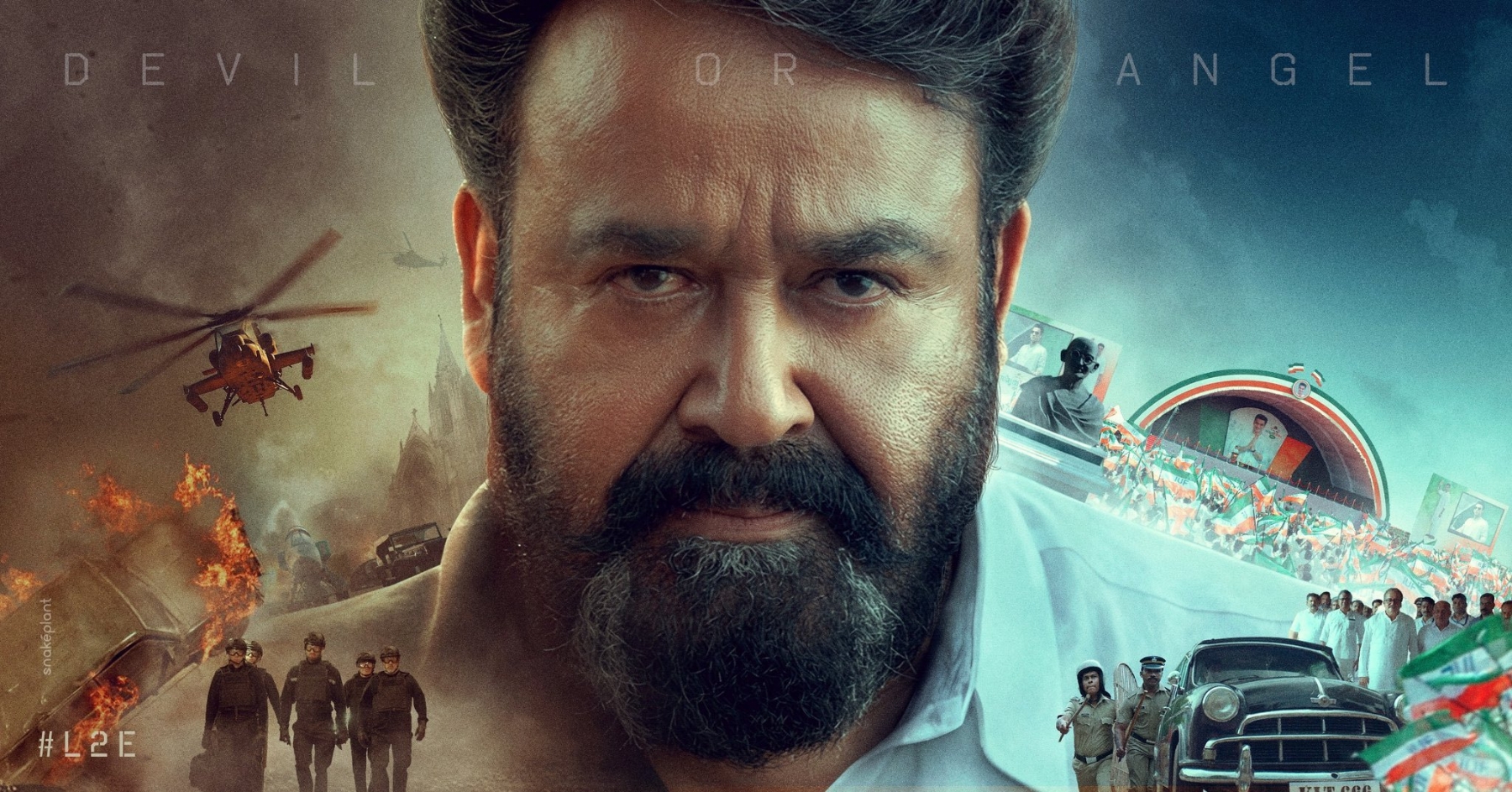Film Review: Empuraan – A Propaganda Masterclass in Communal Polarization
Empuraan is a cinematic crime against truth and harmony. Watch it not for entertainment, but as a case study in propaganda.

Empuraan, a Malayalam-language film marketed as a high-octane political thriller, has become a lightning rod for controversy, not for its cinematic merits but for its unabashed ideological vendetta against Hindu culture, history, and politics.
Clocking in at over three hours, the film is a meticulously crafted polemic that weaponizes cinema to advance a narrative of Hindu vilification, Christian-Muslim exceptionalism, and pro-Congress propaganda.
Erasing Muslim Culpability, Amplifying Hindu Guilt
The film opens with a harrowing depiction of the 2002 Godhra riots, a tragic chapter in Indian history marked by communal violence. However, Empuraan’s portrayal is neither neutral nor factual.

It deliberately omits the initial trigger—the burning of the Sabarmati Express by a Muslim mob in Godhra, which led to the deaths of 59 Hindu pilgrims—and instead begins with Hindu mobs rampaging through a castle, raping pregnant women, and slaughtering children. The omission is not accidental; it is a calculated rewrite of history to absolve one community and demonize another.
Symbolic Framing of Hindu "Barbarism"
The Hindu mob’s introduction is steeped in religious iconography designed to provoke revulsion. They are shown emerging from a temple, brandishing Trishuls (tridents sacred to Lord Shiva), with chants of Hindu shlokas (prayers) playing in the background.

The juxtaposition of sacred symbols with acts of brutality is intentional, reducing Hinduism’s spiritual lexicon to a soundtrack for savagery. This framing implies that Hindu rituals and tools are inherently violent, a trope reminiscent of colonial-era propaganda that painted native practices as "primitive."
"Balraj" as a Hindu Boogeyman
The mob is led by a character named Balraj. Balraj is depicted as a genocidal fanatic, later revealed to be a politician with direct ties to the "Home Minister of India"—a thinly veiled reference to the BJP-led central government.
His portrayal as a scheming, bloodthirsty manipulator reinforces the film’s thesis: Hindu nationalism is synonymous with state-sanctioned terror.
Statistical Reality vs. Cinematic Fiction
The film’s claim that Hindu mobs are uniquely violent clashes with empirical data. According to India’s National Crime Records Bureau (NCRB), Muslims constitute 21% of the prison population despite being 14% of the population, while Hindus, who form 80% of the populace, account for 69% of inmates.
By whitewashing Muslim criminality and exaggerating Hindu culpability, Empuraan peddles a dangerous false equivalence, portraying Hindus as aggressors and Muslims as perpetual victims.
The Christian Messiah: Lucifer
The film’s protagonist, Lucifer, is a Christian vigilante whose name alone is laden with theological irony. In Christian theology, Lucifer is a fallen angel synonymous with Satan, but the film inverts this symbolism, presenting him as a righteous savior.
The African angle, which ignores the continent’s complex socio-political struggles (religious wars, poverty) to focus on "drugs," reduces Africans to passive recipients of Christian benevolence.
Theological Justification for Violence
In a pivotal scene, a priest rationalizes Lucifer’s violent methods: “God created Lucifer to go to evil places and deal with evil people.” This dialogue is not just exposition; it is theological gaslighting.

By framing Lucifer as God’s divine agent, the film implies that violence against Hindus is sanctified, a holy war against "heathens." The subtext is clear: Hinduism is so irredeemable that even Satan (Lucifer) becomes a force for good when combating it.
Ravan vs. Ram
In a confrontation with a journalist, Lucifer glorifies Ravan, the demon king of the Ramayana, as a misunderstood visionary. “Ravan was a scholar, a devotee of Shiva—why is he remembered only as a villain?” he asks. This revisionism, while ostensibly promoting nuance, serves to equate Hindu dharma with tyranny.
By contrast, Ram, the hero of the Ramayana and a divine figure to millions, is reduced to a villainous namesake: CM Jathin Ram Das. The inversion is deliberate—historical heroes are recast as oppressors, while their adversaries are sanitized.
Muslim Whitewashing
The film’s Muslim characters are uniformly sanitized, embodying the "good Muslim" archetype that exists solely to contrast Hindu "evil." Zayed, a Muslim ally of Lucifer, is introduced rescuing girls from human trafficking—a narrative choice that ignores the prevalence of Muslim involvement in real-world trafficking networks (e.g., the Rohingya crisis). His heroism is unblemished, his morality unquestionable.
The Christian-Muslim Alliance Against Hinduism
The climax features Lucifer (Christian) and Zayed (Muslim) joining forces to defeat Balraj (Hindu). This coalition is framed as a moral necessity, with Hinduism as the common enemy.
The symbolism is stark: Abrahamic faiths must unite to purge India of Hindu influence. The post-credits scene, where CM "Ram" is killed by Chinese gangsters, extends this logic—foreign intervention is justified to "cleanse" India of Hindu leadership.
Political Digs
The film’s political agenda is unmistakable. It vilifies the BJP-led central government while valorizing the Congress Party and foreign powers.
The CM’s sister, contesting elections in a tricolor saree (a Congress symbol), delivers a speech about "saving democracy" before being arrested by the Enforcement Directorate (ED). This mirrors real-world Congress rhetoric accusing the BJP of weaponizing agencies like the ED. Her arrest is portrayed as politically motivated, echoing Congress leader Rahul Gandhi’s "democracy in danger" narrative.
In a baffling twist, British intelligence agents are depicted as noble peacekeepers aiding Lucifer. This whitewashes Britain’s colonial legacy in India, including the Jallianwala Bagh massacre and systemic exploitation.
By casting former colonizers as saviors, the film undermines India’s sovereignty, suggesting that Hindu nationalism is a greater evil than foreign intervention. 
The film’s "Deep State"—a shadowy network of bureaucrats and spies—is portrayed as a benevolent force working with Lucifer to stabilize India. This conspiratorial trope, borrowed from Western alt-right discourse, is repurposed here to attack the BJP. The message: India’s institutions are compromised by Hindu extremists, and only a secular (read: anti-Hindu) coalition can restore order.
Kerala’s Communist-Islamist Ecosystem
Empuraan is no outlier; it is a product of Kerala’s entrenched Marxist-Islamist cultural ecosystem. The state’s cinema has long promoted leftist narratives, but this film marks a shift toward overt religious partisanship.
The film’s central family—atheist sister, Christian brother (Lucifer), and Hindu-turned-corrupt CM (Ram)—mirrors Kerala’s demographic shifts.
Hinduism is framed as a relic, with atheism and Abrahamic faiths representing progress. This aligns with Kerala’s declining Hindu population (from 61% in 1951 to 55% in 2011) and rising Christian-Muslim influence.
From Kerala Varma Pazhassi Raja (2009) to Lucifer (2019), Mollywood has often sidelined Hindu narratives. Empuraan escalates this bias, portraying Hindu practices as barbaric and Hindu politicians as fascists.
The industry’s silence on Islamic extremism (e.g., Kerala’s ISIS links) and Christian missionary controversies (e.g., forced conversions) reveals a selective outrage.
Cultural Impact: Normalizing Hinduphobia
Empuraan’s danger lies not in its fiction but in its potential to normalize Hinduphobia. By depicting Hindu symbols as inherently violent and Hindu leaders as fascists, it fuels real-world bigotry.
The Trishul, a sacred symbol of Lord Shiva, is conflated with violence throughout the film.
This mirrors global media trends where Islamic terrorism is sanitized (e.g., "radicalized individuals") while Hindu symbols are pathologized. Such framing risks radicalizing audiences against ordinary Hindus.
The film’s Christian-Muslim alliance against Hindus could exacerbate Kerala’s communal tensions. Recent years have seen clashes between Hindu groups and the Popular Front of India (PFI), a Muslim extremist organization. By valorizing one side and demonizing the other, Empuraan fans the flames of division.
Cinema as a Weapon of Mass Polarization
Empuraan is not art; it is artillery. Its sophisticated production values and gripping plot mask a corrosive agenda: to delegitimize Hindu identity, rehabilitate colonialism, and cement a Congress-Communist-Muslim electoral alliance. The film’s call to arms—that Hindus must abandon nationalism or face foreign-backed retribution—is a recipe for anarchy.
Kerala’s cinema, once a beacon of artistic integrity, now risks becoming a pawn in a global culture war. For Hindus, Empuraan is a wake-up call: the battle for India’s soul is not just political but cultural. For the world, it is a cautionary tale of how cinema can be weaponized to erase history and inflame hatred.
Verdict : Empuraan is a cinematic crime against truth and harmony. Watch it not for entertainment, but as a case study in propaganda.


